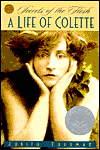Despite the pride and pleasure she took in her discipline [exercise], Colette wasn't deluded about the extent to which a contemporary woman might throw off her fetters ... she writes of [Duncan's] "naive person," and what was specifically naive to Colette was the idealism of her message. It didn't escape her that the women who had come to cheer this "little naked creature in her veils" were corseted from their armpits to their knees, absurdly hatted, slaves to fashion, "heroic and bound." "I muse on how peculiar women are, watching all these ladies who applaud Isadora Duncan ... let us not fool ourselves! They acclaim her but they don't envy her. They salute her at a distance, and they contemplate her, but as an escapee -- not as a liberator." If Colette dreamed of escape, she never underestimated the difficulties posed to women by their desire to remain bound. "Reflecting on it later, it has seemed to me that I was exercising my body in the way that those prisoners who aren't concretely planning a breakout still braid a sheet, sew gold pieces into a lining, and hide chocolate under their mattresses." Colette's gymnastics were flexing a will that aspired to, but wasn't yet fit for, the rigors of freedom.
 One of the things that intrigues me about Colette is her interest in exercise and athleticism; I'm trying to figure out as I read her biography to what extent she's pioneer in this way. I don't know all that much about the history of women and athleticism, and I'd love to find out more. Here's what Colette's biographer says about it:
One of the things that intrigues me about Colette is her interest in exercise and athleticism; I'm trying to figure out as I read her biography to what extent she's pioneer in this way. I don't know all that much about the history of women and athleticism, and I'd love to find out more. Here's what Colette's biographer says about it:Colette was not the first woman of the century to work out, but she was one of the first amateurs. She had just turned thirty, and she had a morbid fear of succombing to the matronly flaccidity that was the fate of the average middle-aged woman of that era. In the process of becoming fit, she discovered that exercise strengthens one's morale. "O molle ardeur de la femme amoureuse" --- O mushy ardor of the woman in love! --- she exclaims. In the gym, she was battling that mollesse, and acquiring a "modern" body: hard, supple, and, from the perspective of her era, androgynous. She was also, consciously or not, training herself for the profession she would take up when her marriage ended. Colette had understood, precociously, that the true beauty of a woman's muscles is identical with their purpose, and that's self-support.
It's interesting (and probably typical) the way Colette seems to combine admirable and questionable motives for working out: she does it to conform to a cultural image of beauty but also to begin to become independent. I like very much what Thurman says about the beauty of a woman's muscles being about self-support.
Here's another passage, this one about the dancer Isadora Duncan:
So in Colette's time and place, strong athletic women like Duncan were admired but not emulated. This makes Colette's own physical ambitions that much more interesting -- she would be someone who would both admire and emulate, gaining strength and turning into a performer herself later on. I like the way she is practicing freedom from the constraints of the patriarchy, even though she can't escape them yet, through physical exertion.
Thursday, September 07, 2006
Colette and athleticism
Posted by
Rebecca H.
at
7:16 AM
![]()
Subscribe to:
Comment Feed (RSS)



|